If you’ve ever carried a pile of power banks on a backcountry bikepacking trip or forgotten to charge your lights before a big ride, you understand the appeal of a dynamo hub. It’s a clever little generator that lives inside your front hub and, via the magic of electromagnetism, generates power when the wheel spins. This power can run a headlight and/or tail light, charge your USB-rechargeable devices, or both, depending on your setup.
Too good to be true? Quality dynamo hubs aren’t a gimmick these days; they actually work and work well. But they’re also not a no-brainer for most cyclists. They’re expensive, for starters, and they don’t magically give you endless charging capacity or constant light. They are another system with its own limitations that need to be managed.
So is a dynamo hub worth it? Last year I upgraded my bikepacking setup in a big way, including a splurge on a $400+ SON dynamo hub. I’ve put about 5500 miles on it so far, a mix of long bikepacking trips (Western Wildlands, Central Asia), back-of-pack bikepack racing (Smoke ‘n Fire 400, Bones to Blue, etc), and riding trails near my house. I’ve learned a ton about what situations a dynamo hub is best for, how to get the most out of it, and where it falls a bit short.
This post is based on my experience with a SON 28 15 110 (28 hole, 15mm thru axle, 110 Boost spacing) powering a kLite Ultra light and charging system. It’s a pretty premium setup that spares no expense and is well-optimized for the type of riding I do. I’m lucky to have it! If you’re wondering whether a dynamo hub is worth it for you and the type of riding you do, I hope this post helps shed some light (so to speak) on the topic.
Shop Bikepacking Resources
digital help with planning, riding, and problem solving
When you buy through affiliate links in this post, I may earn a small commission. Thanks for your support! I always offer unbiased opinions based on real experience from the road and trail. Learn more.
Key Parts of a Dynamo System
A dynamo hub by itself doesn’t do anything — you need to build a system around it. Depending on the system you choose, you may have multiple components integrated into a single item (like a dynamo light with a USB charging port) or you might mix and match for a more modular system. Either way, here are the important parts:
- dynamo hub, built into your front wheel
- dynamo-powered headlight
- dynamo-powered tail light (or alternatively, since tail lights don’t need much power, a USB-rechargeable light that you charge from your power bank)
- dynamo-powered USB charger
- power bank that charges from the USB charger and is used to recharge your phone and other electronics
- optional: secondary battery-powered headlight to supplement the dynamo light, depending on your needs (more on this below)
Some people use a dynamo hub only to power lights, others use it only for USB charging, and many use it for both. For example a commuter might be mainly interested in lights while a bikepacker mostly cares about USB charging. A bikepack racer definitely wants both.
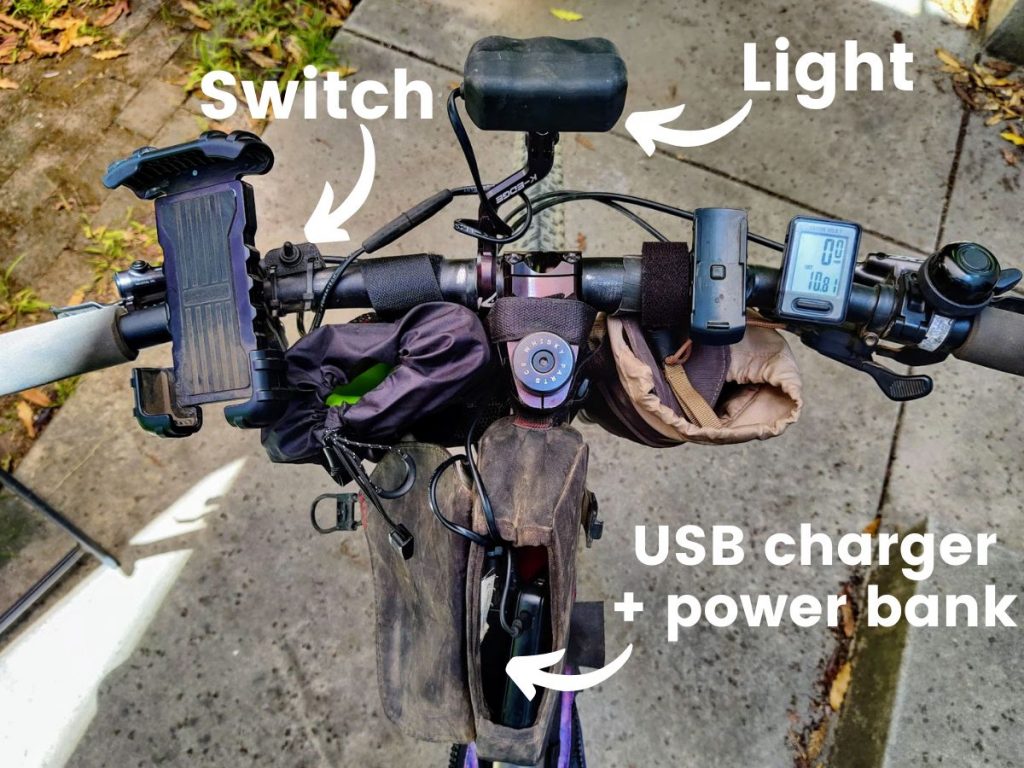
A dynamo hub alone doesn’t help; you’ll need the rest of the system too. Here are the parts of my kLite lighting and charging system.
Things You Might Not Know About Dynamo Hubs
When I first started learning about dynamo hubs, I had a lot of misconceptions about how they work and how to use them. This section clarifies some important points you may be wondering about.
You won’t feel the extra drag. Yes, physics says it takes more pedaling energy to get energy out of a hub, and you can feel this resistance if you turn a dynamo hub by hand. But once it’s attached to your wheel and spinning along, there’s enough momentum that all but the most elite road racers would be hard-pressed to notice a difference. There is a small effect, but it doesn’t matter for most of us.
Brightness depends on speed. When climbing slowly (below 5-10 mph depending on the light) a dynamo light will be dimmer. At hike-a-bike speed it may not turn on at all or may be flickery. Most people keep a second light handy for prolonged, slow, or complex night riding, though it doesn’t need to be as bright or have as much battery capacity as a primary light (some people just use a headlamp).
Some dynamo lights have a “stand light.” If you’re going to spend money on a dynamo system, I highly recommend you get lights with a “stand light” feature. These use a capacitor to store energy for a few minutes after you stop riding or slow below the speed threshold for generating power. If you stop at a red light, take a quick roadside break, or walk your bike around an obstacle, your lights will continue to shine for a few minutes.
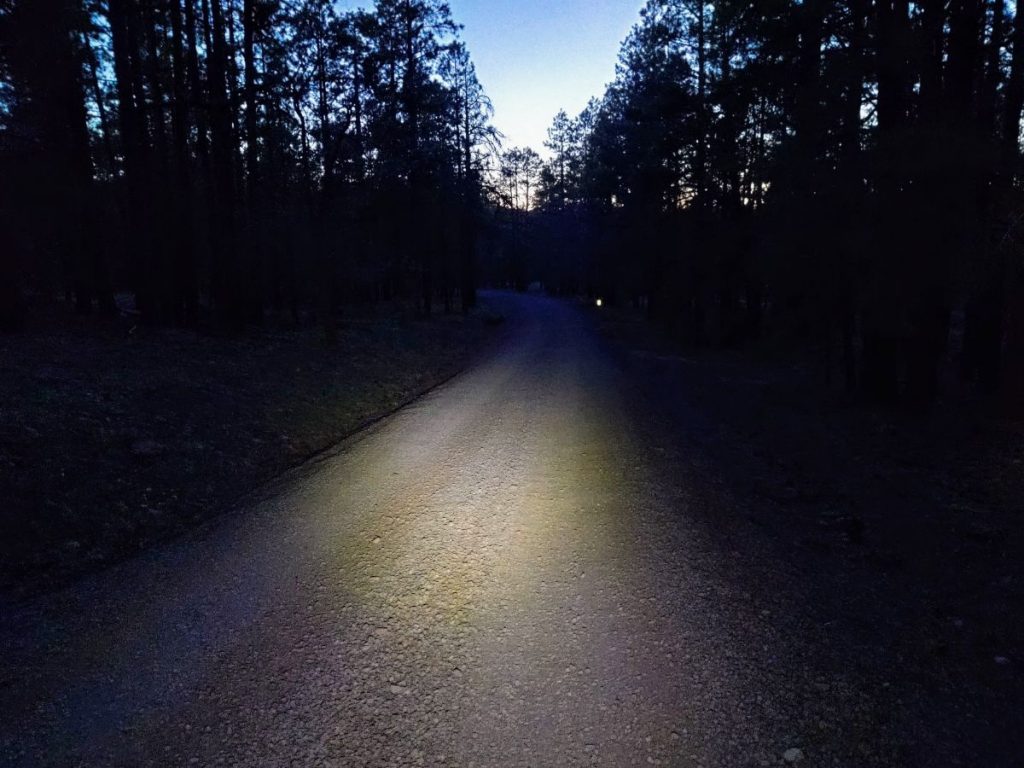
The handy stand light feature on my kLite continues producing light for a couple minutes after I stop.
You might still need a second (battery powered) light. The most efficient way to power a light with a dynamo hub is to do it directly, with a light specifically designed for the purpose. These lights often (but not always, see the Sinewave Beacon for a counterexample) can only be powered by the dynamo. Depending on the type of riding you do, you may still want to carry a battery-powered headlight and tail light so you have light at low speeds or when stopped. When I ride bikepack races (which involve lots of night riding) I run a second light on my helmet for slow climbs and twisty trails.
You need a dynamo powered USB charger if you want to charge devices. AC power from the hub must be converted to DC before it can be used for charging; you can’t simply plug your phone into your hub. Some systems come with a USB charger, either separate or integrated into the light, or you can buy a standalone charger. As with light brightness, the amount of charge you’ll get depends on your speed.
You’ll still want a cache battery. Even with a USB charger, you’ll still want a cache battery a.k.a. power bank (recommendations here). It’s usually best to charge the cache battery while riding during the day (when you don’t need max power for the light) and then recharge your devices from the cache at camp or while riding at night.
You need a backup plan. Though hubs and lights are designed to be highly reliable, there’s always the possibility of failure. If your charging system is mission critical, this is another good reason to carry a cache battery and backup light so you won’t be completely up a creek if something goes wrong with your hub.
You’ll still have to think about charging. It’s true, a dynamo system removes a massive amount of stress especially in a racing situation. But instead of thinking about battery capacity you’re now thinking about the terrain ahead and whether it’ll be fast enough to generate power, when to charge what, and which mode to put your light in.
As you can see, dynamo systems add complexity and aren’t quite magical enough to provide unlimited power all the time. However, as someone who rode and raced without one for years, I totally love having one and would not want to go back.
Reasons to Use a Dynamo Hub
Now that you have a more realistic vision what a typical setup might look like, let’s get into the reasons why a dynamo hub might be worth it.
Unlimited lighting in some circumstances: If you’re able to ride consistently at moderate speeds (above 5 – 10 mph) then a dynamo hub basically guarantees unlimited lighting with no risk of running out of battery. If you’re riding in the dark for hours at a time, no need to guestimate remaining runtime and worry about battery swaps. If you want to run lights during daytime for safety reasons, you’re not wasting battery. On bikepacking trips you don’t have to worry about draining your battery before reaching a power outlet.
“Set it and forget it” lighting: With a dynamo hub there’s no risk of forgetting to charge your light, or taking it off your bike and forgetting to put it back. You don’t need to turn it off when the sun rises, or when you turn off a busy road, to conserve battery. I find this relieves a surprisingly large amount of mental load when I’m on my bike day after day in varied conditions.
Extended USB charging capacity: If you’re bikepacking or touring and need to charge your electronics (phone, nav device, satellite tracker, backup lights, etc) without grid power, a dynamo-powered USB charger reduces the number of power banks you need to carry and reduces stress about them running out. Even if you do run out of battery you can always generate a little bit more in case of emergency.
Depending on the type of riding you do, those benefits might be a matter of convenience or they might be absolutely mission-critical. A dynamo hub doesn’t solve all your power problems perfectly at all times, but it’s another tool in your toolbox and definitely reduces the risk of running out of juice at a bad time.
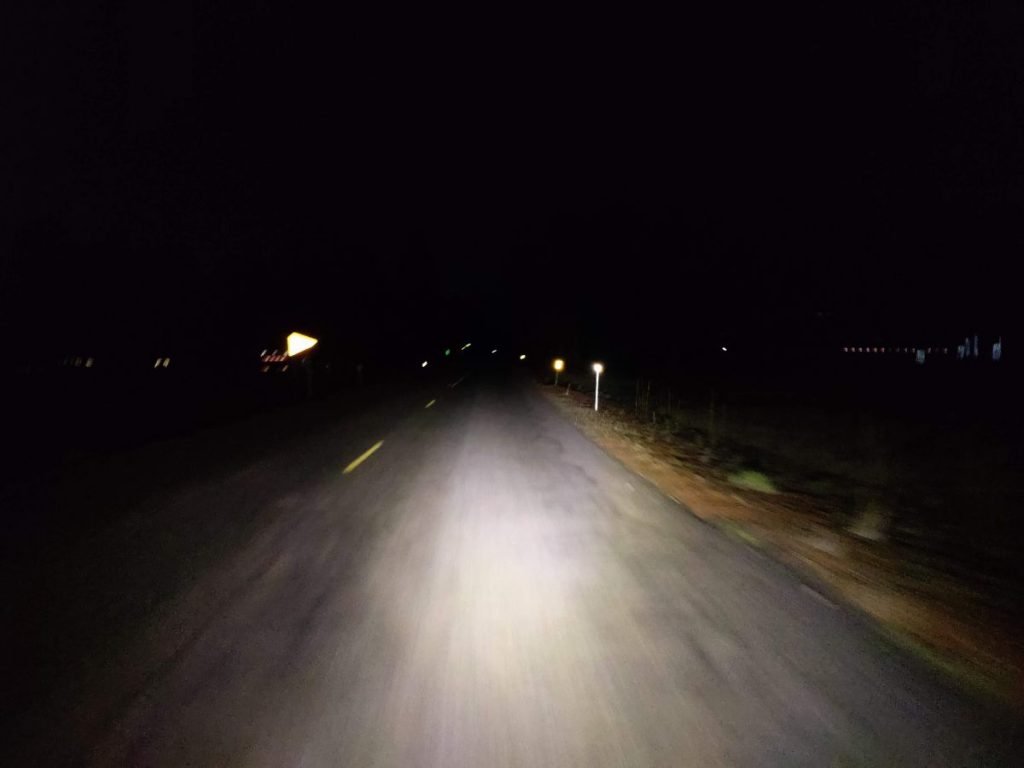
If you often ride in the dark at road or gravel speeds, the unlimited light of a dynamo hub is a fabulous luxury.
Drawbacks of Dynamo Hubs
As much as I love my dynamo hub and would choose it again in a second, I have to admit there are some substantial drawbacks. Think carefully about whether any of these are deal breakers for you.
Cost: This is the big one. A dynamo hub alone costs in the neighborhood of $150 – $400, plus it needs to be laced into your wheel which is probably a job for a bike shop (another $150 of labor in my experience). Then there’s the light and USB charger to go with it, which can cost another several hundred dollars for a quality setup. That’s a fair bit of money to spend if you’re not going to get a LOT of benefit. Of course a normal hub and lights cost money too, but a dynamo setup can easily cost at least 3x as much as a standard hub and battery-powered light, and the more expensive dynamo systems do work better.
Complexity: A dynamo hub opens up a whole new world of research to be done and decisions to be made. You’ll have to consider compatibility between your hub, lights, and charger, especially if you plan to mix and match from different manufacturers. You’ll have to wire everything up and keep an eye on it all to make sure it’s working properly. I personally think it’s cool to have an electronic component to my bike, but in the beginning I was slightly intimidated by the setup.
Weight: Dynamo hubs are heavier than regular hubs. My SON 28 15 110 weighs 480 grams. A comparable high-quality hub like the Industry Nine 1/1 weighs 165 grams. That’s a difference of 315 grams, or 0.7 pounds. Fortunately this weight is well-situated near the center of the wheel, but it does increase the overall weight of your setup a bit.
Harder to switch between bikes: Once the dynamo hub is laced into your wheel it’s going to stay there for awhile, unless you really like rebuilding wheels. You can swap your wheel between bikes if it’s compatible, but you can’t just move the whole setup to any other bike like you could with a battery powered light. If you ride several bikes with different hub spacing, like a road bike and a mountain bike, you would need a separate dynamo wheel for each.
It’s always on your bike. Unless you get another wheel with a normal hub, your dynamo hub will remain part of your bike even when you don’t need it. I’ve been riding mine around my local trails on day rides when I’m not out bikepacking. There isn’t necessarily a big downside to this except that it’s a bit heavier and could potentially wear out a little faster.
Limited light mounting options (no helmet mounts). I strongly prefer a helmet-mounted light when riding at night in remote (i.e. dark) places. Being able to turn my head to the side and see what’s rustling in the bushes helps keep nerves at bay when biking alone through a dark forest. But dynamo lights must be mounted to your bike, so you may want to supplement with a second helmet-mounted light.
Added hassle and expense in case of problems: Higher quality dynamo hubs, like SON and SP, are very reliable. They can usually go tens of thousands of miles before needing maintenance, but unfortunately things do sometimes go wrong. If your hub needs work it’s very unlikely you can do it yourself or even take it into your local bike shop. You may need to send it to the manufacturer, which probably means cutting it out of your wheel and then having to pay for a new wheel build, not to mention shipping for the hub.
When is a dynamo hub worth it?
When it comes to bikes and related gear, the question “Is it worth it?” is almost always a function of both how much benefit you’ll get from it and how much it hurts to part with the money it costs. People with more money might accept less benefit, while those with less money usually expect more benefit. You’ll have to decide the money question for yourself, but I’ll try to explain the benefits.
Self-Supported Bikepack Racing
Even though I’m fairly slow, I still enjoy pushing my limits at bikepacking races and that means riding hours in the dark each night. I used to carry a whole stack of power banks and still struggled to keep everything charged while racing. This was the primary motivation for getting my dynamo setup and I’m so glad I did.
It’s no coincidence that dynamo hubs are extremely popular among bikepack racers. This crazy sport presents the perfect combination of circumstances to make a dynamo both very needed and very helpful. Specifically:
- Heavy power usage: riding through the night requires lots of light, and riding long days drains batteries in phone, GPS tracker, and nav device
- Minimal recharge opportunities: sleeping in the woods, and trying to move through towns as quickly as possible with no time to sit and charge electronics
- Lightweight gear: every pound counts when you’re pedaling 18+ hours a day, so carrying lots of extra batteries or a solar charger isn’t ideal
- Efficient power generation: long miles and faster speeds can generate meaningful amounts of power compared to slower touring-paced rides
In my opinion those four factors add up to the perfect use case for a dynamo hub. Worth it? Heck yes.
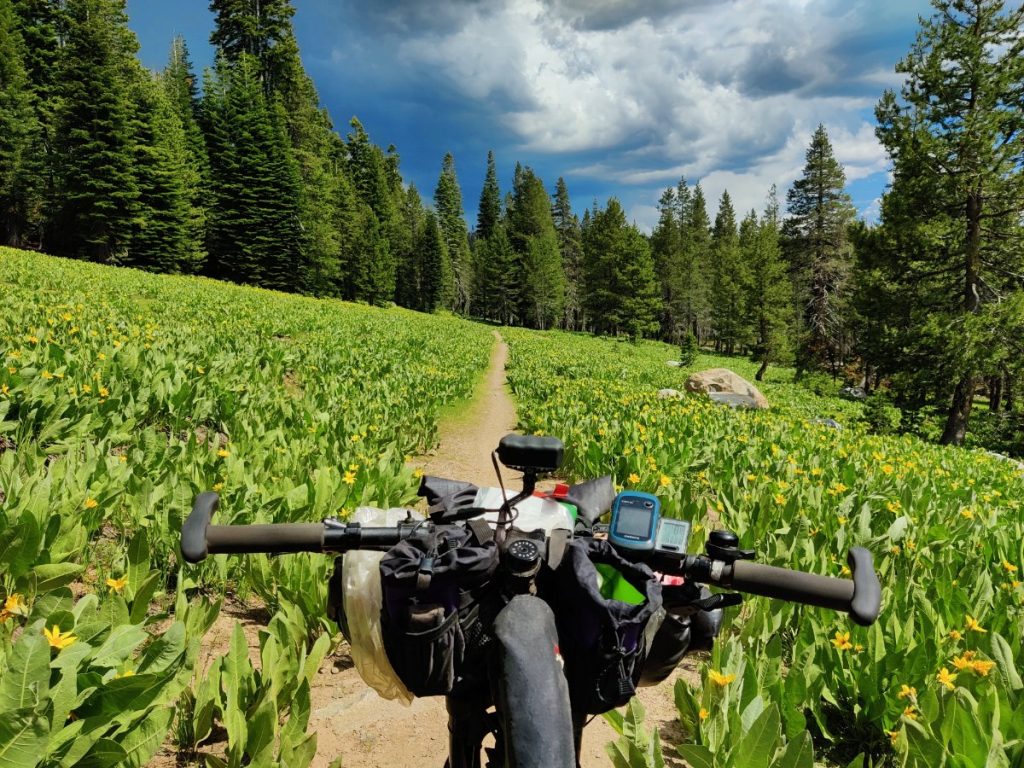
Running my kLite headlight and SON dynamo hub during Bones to Blue bikepacking race, the perfect scenario for getting your money’s worth out of a dynamo setup.
Bikepacking and Touring
Is a dynamo hub worth it for more leisurely bikepacking and touring, as opposed to racing? In my opinion it depends on how remote your trip is, and how far and fast you ride each day.
Remember, dynamo hubs work best at speeds above 8 – 10 mph, which means rides with a lot of steep climbing and rugged terrain don’t generate as much power. Unfortunately these also tend to be the rides with less frequent town stops for recharging. This means the bikepacking trips where you would most want a dynamo hub to be useful are often not the rides where it provides the most benefit.
Related: How to Estimate Your Bikepacking Pace
In my opinion the ideal bikepacking trip for a dynamo hub would have plenty of faster miles on paved or maintained dirt roads, cover at least 50 miles per day, and have stretches of 3 to 5 days between resupply. Trips with more frequent resupplies are easy to cover with a couple power banks. Trips with slower or shorter daily mileage won’t generate much useful power and might be better served with a solar charger, if needed.
I do think long-distance bike travelers, like round-the-world types, can make a good case for a dynamo hub. When you’re on the road for many months or years, you just never know what weird situations you’ll end up in. You might need to do a lot of night riding or find yourself in places with an unreliable power grid. And you’re certainly going to get your money’s worth out of your gear, if you can afford it in the first place.
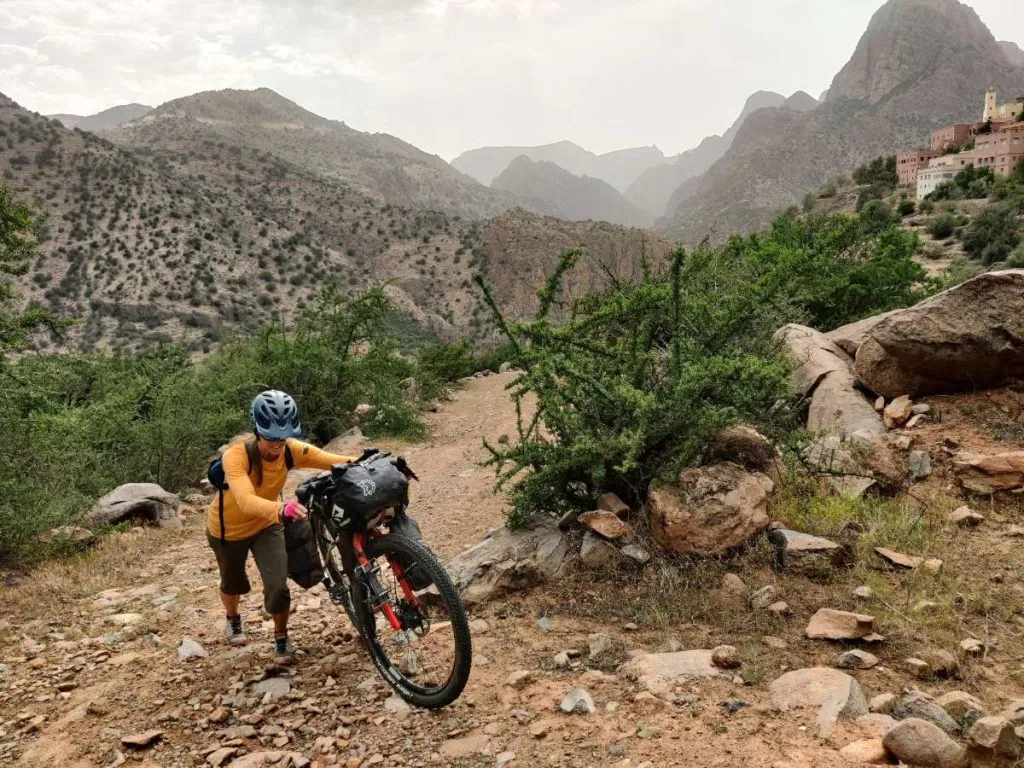
Definitely not generating any power on this super slow hike-a-bike in Morocco
How I use my dynamo hub for bikepacking and touring:
Personally I would not have spent nearly $1000 on my dynamo setup for this use case alone. But since I have it, I do enjoy using it, especially the USB charger and dynamo-powered tail light.
My dynamo-powered USB charger is useful for remote trips where I don’t see a power outlet for 4 or 5 days between resupplies. It relieves stress about running out of power in the middle of nowhere and allows me to carry fewer power banks. It also gives me more flexibility when I do hit a town; I can choose to ride through instead of stopping overnight to recharge everything.
If I didn’t have my dynamo hub I might bring a solar charger to meet my USB charging needs on these trips (BigBlue 28W is my favorite), or just carry power banks. A solar charger is heavier and bulkier than a dynamo hub, but way less expensive and can be transferred between bikes or used for other activities. It also generates power even when you’re not riding (as long as there’s some sun), which makes it more effective than a dynamo hub for trips with low daily mileage or slow speeds.
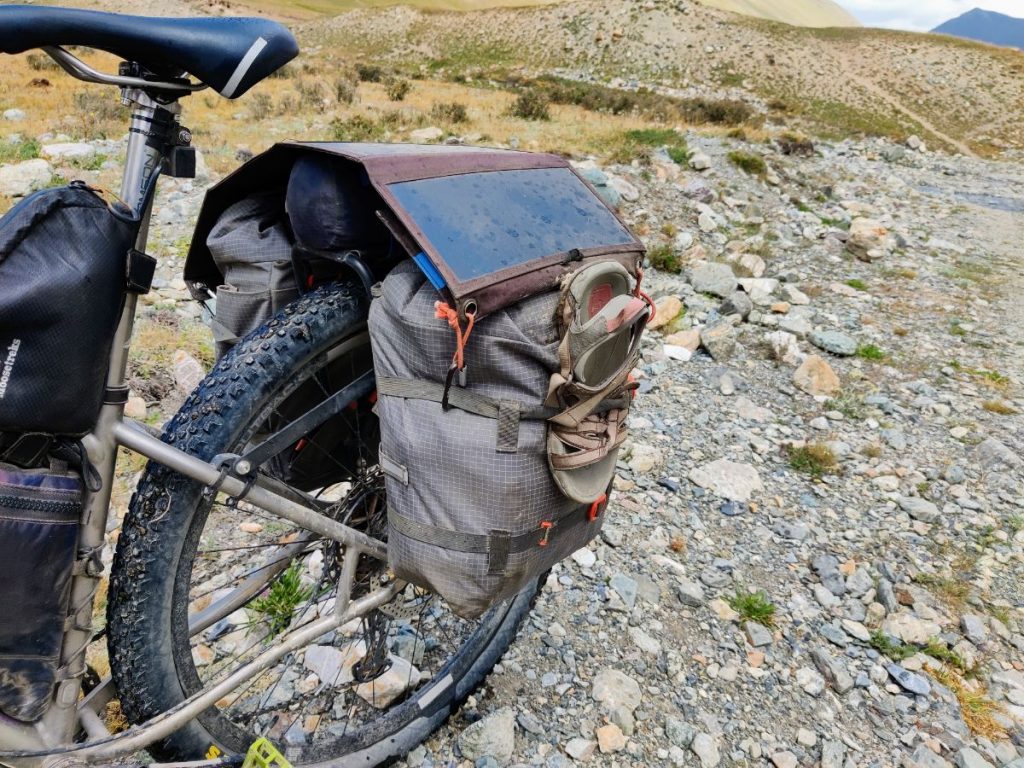
When roads are rough and miles are slow, a solar charger like the BigBlue 28W may be more effective than a dynamo hub.
My dynamo headlight usually stays home when I go on long international rides, like the month I spent in Central Asia, where I don’t do much night riding. It’s an expensive piece of gear and I’d rather not carry it around if I’m not going to use it. My dynamo tail light, on the other hand, I totally love for all kinds of bikepacking and touring. It’s great to have an always-on safety blinker that never needs charging.
Impact of Speed and Daily Mileage
I want to highlight this very important point: whether a dynamo hub is worth it for USB charging depends on how many fast-ish miles you ride each day. “Fast-ish” means faster than about 8 mph, depending on the hub. This calculation is especially obvious for bikepackers, who tend to ride varied daily mileages and mixed terrain. Examples:
I can fully charge a 10,000 mAh power bank with about 150-200 miles of riding on paved or gravel roads, and that distance will take me two or three days. In this scenario a dynamo-powered USB charger provides a helpful, if not luxurious, amount of power.
On rugged 4×4 tracks or singletrack, that same number of miles would charge my power bank only halfway and would take me four or five days. In this situation I’m getting a little bit of help from my USB charger, but not enough to be meaningful.
If you plan to do any night riding on the trip, the same issues apply. A dynamo provides unlimited and sufficiently bright light at road and gravel speeds, except on slow climbs. But many riders find a dynamo light too dim for rough trails, where even more light is required for safe riding but slower speeds result in less power from the dynamo.
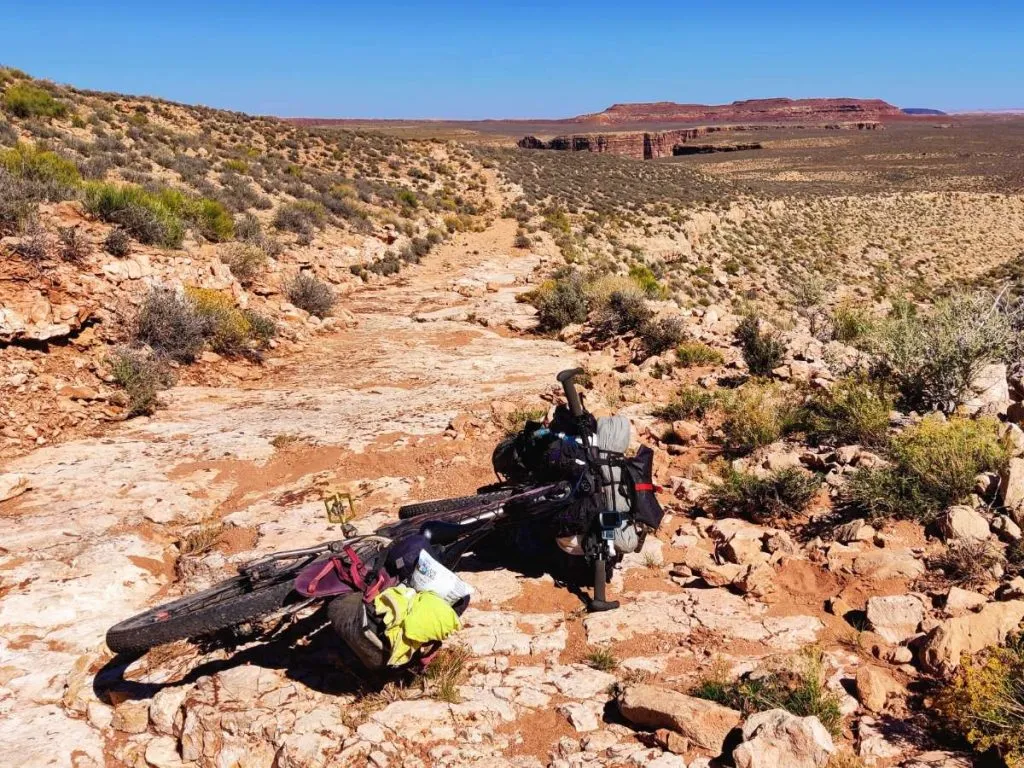
If you like rugged bikepacking routes, you may struggle to cover enough fast miles per day to make a dynamo hub worthwhile.
Commuting
I don’t currently use my dynamo setup for commuting, but many years ago I did commute to work by bike with battery powered lights. Come the shorter daylight hours of winter I was always thinking about my lights and whether they were charged.
I definitely would have appreciated a dynamo setup for commuting in the dark, or even during daylight so I could run “be seen” lights without constantly recharging them. I likely could have gotten away with a less expensive dynamo setup than the one I use for bikepacking, which needs to be super rugged and reliable.
If I had been a die-hard commuter with longer mileage (my commute was only 5 miles) and more money to spend, I think a dynamo hub would have been a much-appreciated convenience. However, I do not think it would have been as essential as it is for the types of riding I do now.
Long Rides and Training
If you’re “just” a regular cyclist who likes long rides, is a dynamo hub worth it? In this situation I think it really comes down to how much the money side matters. If your bike setup already costs $10,000 what’s another $1000 for a dynamo setup? 🙂
Personally I would only consider a dynamo for “day rides” if I did a LOT of riding in the dark. If you train early in the morning or often find yourself very far from home at sunset, you’ll certainly appreciate not needing to worry about the runtime of your lights. But there are other cheaper ways to deal with this (carrying a backup light or USB power bank) as long as you’re sleeping somewhere with a power outlet the night after your ride.
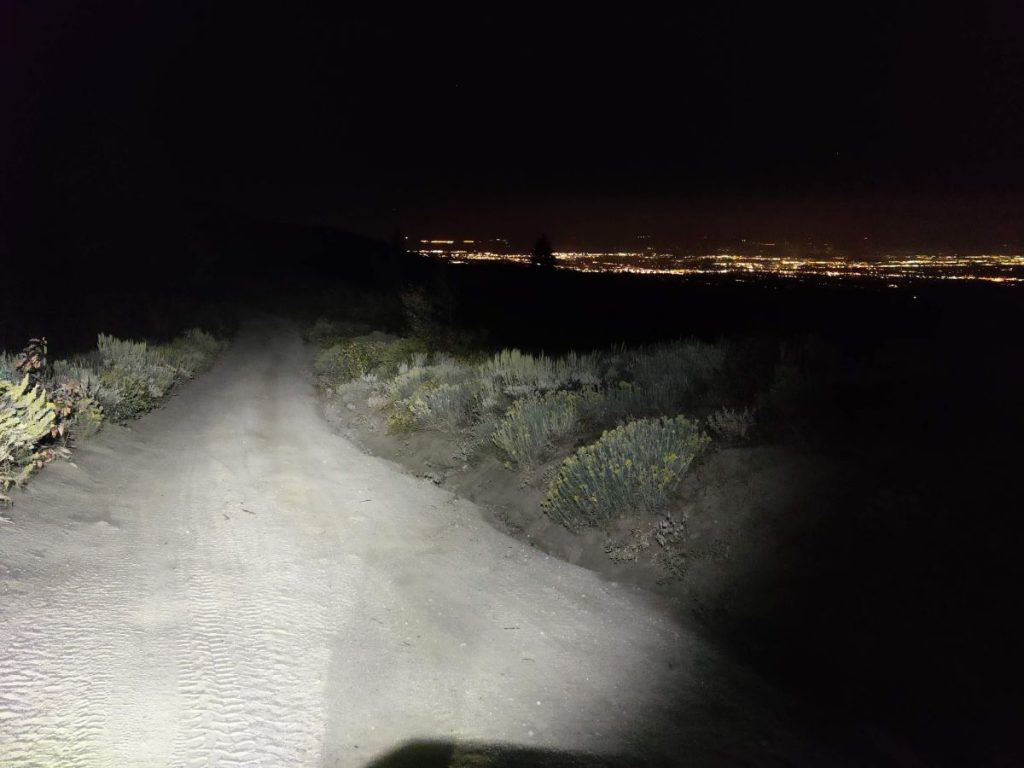
Do you often find yourself hours away from home when the sun sets? Then you might enjoy a dynamo setup.
Popular Dynamo Hubs
If you’re thinking a dynamo hub might be a worthwhile investment, here are the top brands to consider:
Schmidt SON hubs: Schmidt is a German brand known for making the most premium dynamo hubs available ($320 – $450 price range). Supposedly they last many tens of thousands of miles, and their efficiency and drag numbers are either the best or close to it.
Shutter Precision (SP) hubs: Shutter Precision is a Taiwanese hub maker with offerings in the $100 – $250 range. They are known for being solid and a good value but not quite as much of a “forever hub” as SON.
Shimano dynamo hubs: Shimano has several models of dynamo hubs in the range of $100 – $200. The cheapest models are lower power but the others are considered a good value.
Are more expensive hubs worth the money? Ideally you’d expect a pricier hub to be more efficient, have lower drag, and need less maintenance. People have done tests, like this one, to quantitatively compare efficiency and drag. When looking at results it’s important to consider what riding speed you want to optimize for, as each hub has a curve of values depending on speed.
As for reliability, there are plenty of anecdotes out there about hubs that have lasted forever and others that have failed. I have an anecdote myself: my SON hub actually had to be replaced per the warranty around 5000 miles due to a bearing issue, despite being the most reliable and long-lasting brand (guess I got very unlucky). Just goes to show that even a premium product is no guarantee of perfection, and there is good value to be found at lower price points.
People buy SON dynamo hubs for reasons like these:
- I plan to ride tens of thousands of miles in all kinds of conditions and I want a “forever hub” (bikepackers and tourers, usually).
- I’m already spending so much money on this setup, may as well spring for the best rather than save a little bit of money and risk being disappointed.
People buy SP and Shimano hubs for reasons like these:
- I don’t plan to put a ton of miles on my hub and/or I don’t ride in really wet or rough conditions (road riders and commuters, for example).
- I don’t need to eek out every last bit of efficiency or speed for the type of riding I do, so I don’t care if efficiency and drag are slightly worse.
- I want a dynamo hub for any kind of riding, but simply can’t afford a SON.
When shopping for any dynamo hub be sure to keep in mind the following specs:
- Brake type: rim versus disc (and 6 bolt versus centerlock)
- Hub spacing: needs to be compatible with your fork
- Axle type and diameter: thru axle, QR skewer, etc
- Spoke holes: needs to be compatible with your rim, style of riding, and typical load
More Bike Resources
If you liked this post, you might also like these:
Or visit the bikepacking and cycling sections for lots more.
About the Author
Hi there, I’m Alissa, founder of Exploring Wild. I’ve traveled over 19,000 miles by bike and still can’t stop planning my next ride (and helping you plan yours). Pavement and panniers or singletrack and seat bag, I love it all. On my bike I feel free. Learn more about me here.
Shop Bikepacking Resources
digital help with planning, riding, and problem solving
Bike resources in your inbox?
There’s more where this came from! Sign up here for occasional emails full of inspiration and information about bikepacking and bicycle touring.
Share the Adventure
If you found this article helpful, please consider sharing so more people can benefit from it:
The post Are Dynamo Hubs Worth It? My Take After 5000 Miles appeared first on Exploring Wild.
https://exploringwild.com/are-dynamo-hubs-worth-it/?utm_source=rss&utm_medium=rss&utm_campaign=are-dynamo-hubs-worth-it
 CampingSurvivalistHuntingFishingExploringHikingPrivacy PolicyTerms And Conditions
CampingSurvivalistHuntingFishingExploringHikingPrivacy PolicyTerms And Conditions
